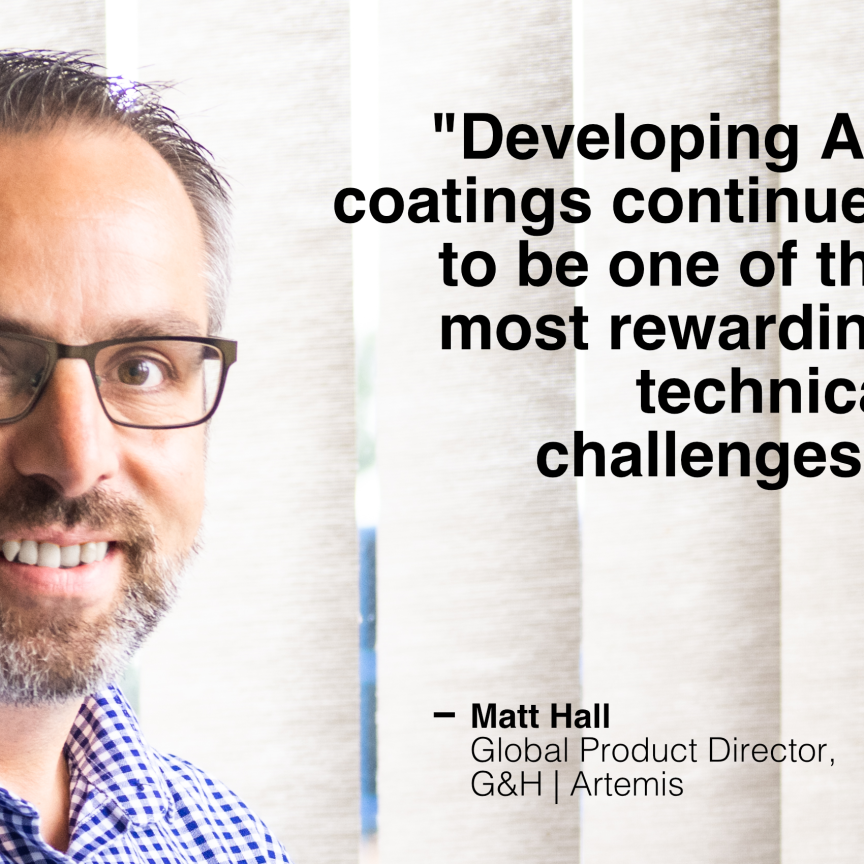While optics can be used to manipulate light in a variety of different ways, whether that’s through a lens, a mirror, beam splitters or filters, what sharpens the optical properties of these components are their coatings. Coatings are applied to virtually every optical device and are essentially used to control light. They are used in numerous applications, from barcode scanners, which have anti-reflection coatings as well as wear-resistant coatings, to cell phone cameras, to optics used in high-power laser systems.
The need for optical coatings becomes apparent when considering that a regular piece of crown glass will reflect approximately four per cent of light striking it – and, for glass with a higher refractive index, reflection could be up to eight per cent. Therefore, in an assembly of uncoated optics, with various lenses lined up sequentially, the reflections from each surface will, firstly, significantly reduce the amount of light passing through the system and, secondly, result in ghosting of the image.
Anti-reflection coatings are designed to reduce the amount of reflection from a lens surface, the most basic of which is a single layer of magnesium fluoride, which will reduce reflection from four per cent on a piece of standard crown glass to less than 1.5 per cent across the visible spectrum. More complex anti-reflection coatings of four or five layers can be tuned to less than 0.4 per cent average reflectance across the visible. So, instead of 96 per cent transmission for each surface, that figure is increased to 99.6 per cent or better – a significant improvement in the amount of light transmitted and in the image quality.
Anti-reflection and high-reflection (for mirrors) coatings are two major groups of optical coatings, but there are also other types that fall between these categories, such as thin plate dichroic mirrors, which reflect certain wavelengths while transmitting others, or cubic beam splitters that produce a similar result without beam displacement. Partial reflectance coatings are a further variety used commonly for output couplers within laser cavities. Coatings can also be used to change the surface characteristics of a material. If optics are used in very corrosive environments, coatings can be designed to protect them.
Deposition techniques
‘The definition of a good coating varies with the application,’ notes Robert Crase, assistant director of commercial manufacturing at Deposition Sciences, ‘but generally it has to be evenly distributed; it should be durable, standing up to certain levels of abrasion, humidity, and heat; and the performance should be optimised. Consistency is also important in optical coatings.’ In addition, he says that the production of an effective coating rests on the specifications provided by the end user, but also on a good understanding of the application by the coating manufacturer.
Deposition Sciences, based in Santa Rosa, California, US, produces optical thin film coatings, largely through a process termed sputtering, which, Crase believes, is rapidly becoming the standard in deposition techniques. ‘Magnetron sputtering produces very durable, uniform films relatively quickly compared to the other technologies,’ he says. ‘In addition, the amount of parts that can be put in a single batch is larger, which makes the technique cost effective.’
A more traditional technique, and one which is still commonly used, is applying the coating under vacuum by evaporation. The optics are heated to 200-250°C, which helps adhesion and increases the properties of the film. The method of evaporation is normally via electron gun, i.e. under high voltage a tungsten filament will eject a beam of electrons, which are magnetically steered onto the coating material. This produces a temperature of around 2,000-3,000°C, which melts the material and produces a vapour under vacuum, which then deposits on the glass.
Iain MacMillan, corporate director of optical coatings at Edmund Optics, comments: ‘While this method has been successful for many years and while the materials do generally adhere well to glass, producing reasonably consistent and predictable films, there is some porosity in those films that can lead to coatings being slightly unstable.’ The pores can absorb moisture, which over time can alter the refractive index of the deposited materials, thus shifting the target wavelength of the coating. To reduce this effect, many companies applying coatings will use an ion gun in a process termed ion assisted deposition (IAD). Here, a beam of energetic ions is fired at the substrate surface and by transfer of kinetic energy from those ions to the depositing molecules, the depositing material has higher energies creating higher quality films with fewer pores.

Virtually all optical components require a coating of some kind to enhance their optical properties. Image courtesy of Laser Components.
Mirroring Crase’s earlier remarks, MacMillan states: ‘Over the past 10 years, there has been a move away from evaporation towards sputtering.’ The sputtering process deposits materials at much higher energies than evaporation or IAD and the properties of the films are much closer to the bulk materials, with little or no porosity. These coatings are therefore very stable and shift free; ‘There’s no change in performance after removing the films from vacuum or over the life of the coating’, says MacMillan. ‘Sputter deposition is also more precise and more predictable than evaporation and therefore more complex coatings can be deposited with results that are very close to the theoretical designs.’ Edmund Optics, a supplier of optics, imaging, and photonics technology, uses an Advanced Plasma Reactive Sputtering (APRS) platform to produce optics with high-precision custom coatings. The platform is able to deposit more than 200 shift-free layers per coating run.
High-power laser systems
The complexity of optical coatings will depend largely on the application and the level of performance required. It may be that a single layer is sufficient for the application and there’s no need for a more complicated, multi-layer coating. Another determining factor is the bandwidth of light required – is this purely in the visible spectrum or is it a system that requires a greater band of wavelengths extending into the infrared or ultraviolet? Both the required performance and the bandwidth will factor into the complexity of the coating and ultimately the cost.
For more specialised applications, such as the optics used for high-power lasers, more complex coatings are required. In terms of high-power laser applications, the materials used must be able to withstand the laser power. Furthermore, according to MacMillan, materials are different for high-power continuous wave lasers than for high energy, nanosecond pulse width lasers. This is because the mode of failure differs: for CW lasers, materials have to be resistant to thermal energy, whereas for short pulse lasers, materials must withstand high electromagnetic field intensities.
Laser Components, a company providing components and services in the laser and optoelectronic field, develops customised coatings for high-power laser applications, although the company does produce coatings for lower power applications as well. It uses various deposition methods for high-power laser applications, including IAD, which gives a hard coating with high damage threshold for use with very high-power lasers.
Bernhard Russell, technical sales engineer at Laser Components, says the deposition process has to be monitored quite closely. Laser Components has an online monitoring system to adjust parameters inside the coating chamber and Russell notes that the ability to do this is one of the factors that has led to improvements in the effectiveness of optical coatings.
Laser Components also manufactures other customised coatings and has developed anti-reflection coatings optimised for four separate wavelengths on one substrate. Generally, anti-reflection coatings fall into two types, either broadband anti-reflection covering a range of wavelengths (400-700nm, for example), or V-shaped anti-reflection optimised to one particular wavelength (the Nd:YAG wavelength of 1,064nm, for instance). Each coating material is first chemically designed to transmit certain wavelengths of light for a specific purpose before it is applied to the substrate. ‘The challenge lies in engineering a coating optimised for a number of different wavelengths,’ says Russell.
A four-way optimised coating needs to follow several stages in which the different materials tuned for each wavelength are applied. ‘It’s a layering process, whereby each coating is applied in very thin layers, often referred to as a stack,’ explains Russell. These types of complex coatings would be beneficial to university research departments, for example, that use four lasers operating at different wavelengths. The same lens could be used for each of the lasers. Optics for both the Nd:YAG wavelength at 1,064nm and also frequency doubled 532nm wavelength, is a further example of where an anti-reflection coating designed for multiple wavelengths is advantageous. ‘It cuts down the number of optical components required, as only one lens is needed rather than having a different lens for each wavelength. This is cheaper and more convenient, as lenses don’t need to be changed,’ he says.
Advances in coatings
Russell believes the biggest ongoing change in optical coating technology is in the coating materials themselves. Factors such as laser power, wavelength and polarisation of the incident light, and heat load are generally all coating material choices, with certain materials being more suited to certain heat loads than others, for example, although according to Crase of DSI, wavelength of the incident light can also have an impact on the deposition technique used. For example, the sputtering materials designed for wavelengths in the far infrared used in thermal imaging are very expensive. Crase notes that an electron beam system would be more economical, as the coating materials can be produced cheaper. In addition, the coating materials used in the deep UV (below 300nm) contain fluorides, which are extremely difficult to apply by sputtering.
Crase says that advances in coating technology have allowed plastics to be coated. This opens up a lot of applications where glass optics, which have to be moulded and polished, are too expensive. ‘Plastic optics are cheaper to produce, but if they are to affect the light hitting the system, coatings need to be applied,’ he says.
One of the areas where advances in optical coatings are having a big impact is in the biomedical sector. ‘We’re seeing more requests for higher performance coatings in areas such as biomedical applications for fluorescence filters,’ comments MacMillan of Edmund Optics.
Molecules containing a fluorophore will fluoresce at a specific wavelength when excited by a separate wavelength and are often used as biological labels in areas such as gene expression studies. Researchers will look to discern emission wavelengths from excitation wavelengths, often at very low energy levels. ‘The optics need to be able to discriminate between excitation and emission wavelengths, which can be relatively close in a spectral band,’ explains MacMillan. ‘Therefore, very high performing filters are required to distinguish between them.’ The filters have to be high transmission with exceedingly high blocking or attenuation away from the specified emission wavelengths.
‘Producing these specialised filters requires a high level of control in the deposition process with highly predictable and consistent results,’ says MacMillan. ‘While this can still be achieved by evaporation, it is proving to be more efficient to generate the films using sputtering technology.’ A move towards sputtering, along with the development of more specialised coating materials, is enabling optics to be produced for these sorts of demanding applications.


